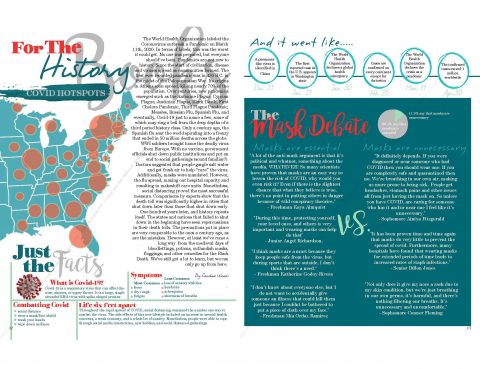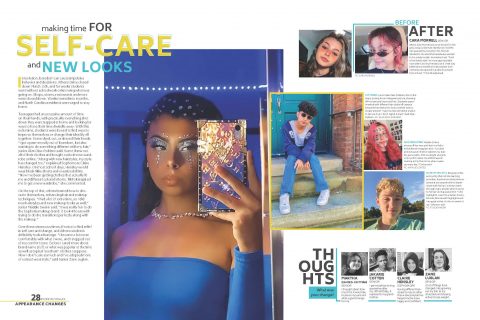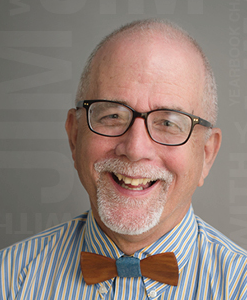Staffs and advisers around the country are rising to the challenge to tell the story of this unique year in their yearbooks.
From coast-to-coast it’s been such a radically different experience for every yearbook staff.
Some of you have been meeting in person, in class, and as a school every day since the first day in August. Others have started out online, then moved to some kind of a hybrid model with some students meeting on campus while others remain at home. Still others have been in distance learning mode since day one and have never seen each other for even one day in person.
Whatever the challenge you have faced, one thing is clear. Yearbook staffs and advisers are some of the most creative and resilient people on the planet.
Give them a task with obstacles they have never dealt with before and they won’t give up. They will work together to make it work because they know just how important it is to create a detailed visual and written record of this crazy year.
Take a look at some of what yearbooks staffs are covering and how they are structuring their pages.
We will be using this series to highlight the work yearbook staffs around the country are doing. Check out parts two and three of this series, or visit our gallery to see even more.
Southern Alamance High School, Graham, North Carolina
Lynn Bare, adviser
Learning model: 100% remote this year. Students have the option to return to school on January 20 or remain remote.
Editors/staff who worked on the pages. “Wacky Weather” – Finley Cameron, Copy Editor. “New Teachers” – Noelle Johnston, Staff Member.
What has been the most challenging aspect of creating pages this year? The most challenging aspect of creating pages this year is that I am in one location and every student is in a different location. I can’t sit with them and help when they struggle. They work, I review, my editor reviews and my rep, Brooke Smith, reviews. Then I put the student in a breakout room on Zoom and we talk about what they need to do. It is exhausting for all parties.
How have you overcome these challenges? We are still working on overcoming these challenges. Breakout rooms help.
What have you learned in the process of creating these pages? Templates are more important than ever before this year, both pages and mods.
What advice would you give other advisers as we move into the second half of the year? Hang in there and make sure you have templates.

Meet the New Peeps. This spread a great way to introduce the new teachers on your staff. Strong columnar design and use of color blocking. Have the subjects provide their own photos they have taken themselves.

Wacky Weather. The strong modular design provides a way to display a wide variety of facts about this year’s weather in the North Carolina area. Fun typography and use of color really make this spread stand out.
Galileo Magnet High School, Danville, Virginia
Michelle Larking, adviser
Learning model: We started the school year (about a month late!) with total virtual classes. Then on November 9, we changed to hybrid. For us, that meant that some of our students were still full time virtual, some came face to face on A days and others came face to face on B days. We did this for two weeks and then had Thanksgiving break. It was decided that we would move back to virtual for the week after Thanksgiving, but then the COVID cases increased so much in our city that the school board decided we will stay virtual until January 25th. Of course, that is subject to change….lol.
Editors/staff who worked on the pages Editors: Ainsley Allen and Caroline Woods Staff: “Dear Covid” is by first year staffer Alexia Chacon, “For the History Books” is by Caroline Woods, and “Mask Your Feelings” is by Emily Ebalo.
What has been the most challenging aspect of creating pages this year? For the staff, I think the biggest challenge has been getting students to respond to picture and interview requests. We tend to have certain students who respond to nearly every request and the rest seem to never respond at all. Because fair and complete coverage is so important to us, this challenge has caused us to get really creative and really bold. We have “stalked” kids on social media, called parents, and nagged girlfriends and boyfriends to have their significant others call us. We have created announcement slides and sent a gazillion emails. We just have to be persistent. I also have had to accept that we may have more coverage of some people than we do others, and I have had to relax my rules as an adviser about that. We are still trying to get everyone in the book though.
Another challenge has been teaching the new staff members about page design, writing, photography, captions – just all of it – without having them here in the room with me. I like to partner new staff members with experienced staff, but since we cannot be on the same page at the same time, the partnership in the virtual world has not worked very well. To overcome this, the editors and I hold conferences with the new students and coach them along the way. And of course, the online workshop we attended at the beginning of the school year really helped sooooo much!!
What have you learned in the process of creating these pages? We have all really learned to step up our creativity and to be brave enough to venture out into areas that we would not have before. We are using more color, editing photos, doing things bigger on the pages than we have in the past. The kids, I believe, are learning the importance of the written story telling aspect of the book as well. We all recognize that this year is a BIG DEAL!! We want to cover the stories with pictures and words. In the past, the kids didn’t see the need for written stories. This year, they have really seen the importance of them.
What advice would you give other advisers as we move into the second half of the year?
- Embrace creativity!! This is a weird year!! That makes it a good time to try things you might not have tried before.
- Also, listen to the stories kids talk about – the videos they watch, the things they care about, the things they laugh about, the things they worry about. Those make great topics to cover in the book!
- And finally, the most fun thing is getting to know the special things about each of the students in the school. Doing feature articles has been amazing because it has given us an opportunity to shed some light on some really cool talents the students have. A neat way to find subjects for these articles is to ask students to nominate kids they know for feature articles.

Dear Covid -19. This is a great coverage idea that surfaced last spring in some 2020 books. Have students write personal letters addressed to the Covid-19 virus and express the way the virus has affected the personally. The use of color and type allow you to create a layout when no photos are available.

For the History Books. The use of color, type and graphics have eliminated the need for any photos. The quotes and information given provide a great historical record of the pandemic in their school community.

Mask Your Feelings. Great type effects and color blocking make this spread stand out. The staff has done great job reporting on the effects the virus has had on the mental hearth of their students and community.
Athens Drive High School, Raleigh, North Carolina
Elizabeth Luna, adviser
Learning model: We’ve been 100% virtual, possible return with a 3-week rotation at the end of January
Editors/staff who worked on the pages: Editors Jacob McCarthy Adams and Sarah Thomas support all layout design and writing. “First Day of School” – Sarah Thomas. “Your Voice Counts” – Peyton Joyner and Zoe Politis. “Entertain Yourself” – Evan Biesaga
What has been the most challenging aspect of creating pages this year? Participation has been a huge issue at our school. Many students are quarantined and all events keep getting cancelled so it’s been a struggle to actually get students to submit photos and “create events” to “cover.” Also have had problems getting kids technology they need to photograph the few events that have occurred. Even my top students have struggled with motivation and purpose these last few months.
How have you overcome these challenges? We’ve been doing lots of alternative copy and finding ways to reduce photography needed on a spread. Also, I have had my leadership team coming into school one day a week for the last month trying to fill holes and rework pages so that they are useable submissions. We did a submission contest on social media and gave a gift card out to one student that submitted a photo that was useable (done through a drawing).
What have you learned in the process of creating these pages? Capitalize on a good photo when you can, design must be driven off of what you can get (whether its good or not). Because we cannot control what we are getting like we usually do, students are learning to pivot spread topics quickly and getting used to having to shift spread design as we go.
What advice would you give other advisers as we move into the second half of the year? Be open to constantly changing a concept of a page, attempt to meet with students as much as possible to help them see the need to pivot a direction before they have wasted their time on a concept that is not working. Give students second chances – give work back to them to redo or change more than you normally would because they aren’t getting as much constant feedback, they aren’t growing as fast as your typical staff – they need more time to “learn” what you used to teach in a matter of days.

First Day of School. The full DPS photos and dominant type design with just a small paragraph of content type tell a clear story of what the first day of school was like. Photo was taken by a yearbook photographer of a student who was a neighbor.

Your Voice Counts. Connecting with the design look established early in the book, this design is a part of their election coverage. If you can set up photos like this using the staff’s DSLR cameras, Full page photos are a great way to expand your coverage both visually and verbally.

Entertain Yourself. This spread expands coverage by using a modular design with six different stories. The headline design creates a strong visual connection and links to other spreads in the book. Notice the extra graphic touches – contrasting colors, icons, black and white photos.

Self Care and New Looks. One great dynamic dominant photo and typography makes this a visually stunning spread. Notice the use of white space to separate the different elements on the spread.
Stoney Creek High School, Rochester Hills Michigan
Sarah Millard, adviser
Learning model: We have been 100% remote except for a two-week hybrid model that was a disaster, so we went back 100% remote until at least Jan 19.
Editors/staff who worked on the pages: Alexia Frazzitta and Maggie Hann
What has been the most challenging aspect of creating pages this year? Coming up with content to cover once we got tired of pandemic stuff. All clubs and sports are currently on hold and learning is 100% remote.
How have you overcome these challenges? Getting VERY creative with content and doing A LOT of totally modular student life type spreads.
What have you learned in the process of creating these pages? My students will rise to any challenge.
What advice would you give other advisers as we move into the second half of the year? Keep encouraging your staff members even for the smallest things – an awesome title, a great quote in a caption, WHATEVER. They need the extra motivation right now.

Let’s Be Real. This work in progress uses great story telling photos and a strong eyeline. So much great coverage here that could be expanded into multiple spreads if needed.
See more spread
Be sure to check our 2021 Coverage Gallery to see more examples of how yearbook staffs are creating books in this strange year. And read part two and part three of this series for more spreads and background information from the school.




